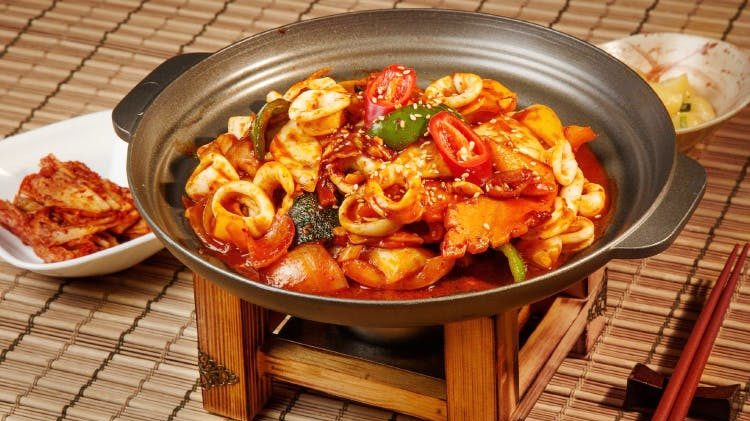Jjamppong or Jjampong (짬뽕) is a popular Korean dish. It is a red and spicy noodle soup that is loaded with various type of seafood such as mussels, clams, squid and prawns. The heat makes it comforting to consume on cold days while the sweetness of the seafood is refreshing!
Origins and History
The dish itself is derived from the Shandong-style Chao Ma Mian (炒码面). While the Chao Ma Mian has nothing concerning the name Jjampong. It is because the Chao Ma Mian is a dish served in Chinese restaurants in Korea, operated by Chinese immigrants.
During the Japanese occupation in 1910 to 1945, the Japanese saw the Chao Ma Mian in restaurants and renamed them as Chanpon, as with their Japanese Chinese dish of Fujian-style Men Mian (焖面) as the white soup base is similar to those of Chanpon in their eyes.
Later, Chanpon is phonetically adapted into Korean as Jjampong. Essentially, the jjampong is not a Korean dish but a Korean Chinese one. Once a white soup base has now become red with the addition of gochugaru (chilli powder) and chilli oil to the jjampong dated back in the 1960s.
Like the jajangmyeon (자장면), Korean black bean noodles, which is also a Korean Chinese dish, jjampong’s popularity competes with the jajangmyeon. There is always a dilemma as to which meal to choose.
So, if one cannot decide between jjampong or jajangmyeon, you can always order a jjamjjamyeon (짬짜면), which is like a yin-yang bowl of noodle goodness. The jjamjjamyeon has both noodle dishes served in a bowl divided in the middle. That is one dilemma solved cleverly to avoid compromisation!
Jjampong Variations
As with many other cuisines and dishes throughout the world, jjampong has its variations too. Listed are just some of the varieties of jjampong that can be found in restaurants:
- Samsun jjampong (삼선짬뽕): a more expensive option loaded with additional variants of seafood
- Gul jjampong (굴짬뽕)/ Sacheon Tangmyeon (사천탕면): jjampong served with oysters along with the spicy white broth
- Gochu jjampong: a version of jjampong with added spiciness using the Cheongyang chilli peppers
- Panfried jjampong
- Jjampong bap (짬뽕밥): rice is used instead of noodles in the hotpot
Perhaps after trying out the original seafood jjampong, you would want to try out some of these variations?
A Jjampong secret: What’s in the soup base?
Usually, kelp and anchovies make a delicious soup base with a tinge of seafood flavours. Chinese household would often keep salted, dried anchovies as part of the ingredients shelf as the saltiness of the anchovies makes it versatile to be added to many dishes.
To make the base, kelp, anchovies and water are combined and cooked for medium-high heat for 20 minutes and simmered for another 20 minutes on low heat to produce a flavourful stock. Some recipes would add in vegetables with the stock ingredients to create a broth.
Pick Your Own Seafood
As to what makes the jjampong unique to a district, restaurant or individual – seafood variations. Prawns, mussels, squid, clams etc. One gets to decide what makes it into the jjampong and what does not.
Focussing on the squid version of jjampong, different types of squids can be added, but it requires some skills to perfect the squid jjampong. Squids are very quickly cooked and without the right timing. Overcooking is always the main challenge as squids can be chewy and hard.
While the mixed seafood jjampong has more ingredients to it, individualised jjampong can be a unique experience to many. Squid lovers, you have to try the squid jjampong to obtain the refreshing sweetness of seafood while not losing a kick of spice!
Have a Jjampong at these places!
Have a Squid Jjampong with friends and family at some of these places like Gangnam88 and Oiso Korean Restaurant which offers seafood hot pots to share! Jjampong on a hot day is a superb dish indeed! Find more of Korean food on foodpanda!
